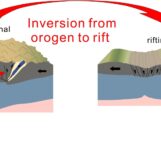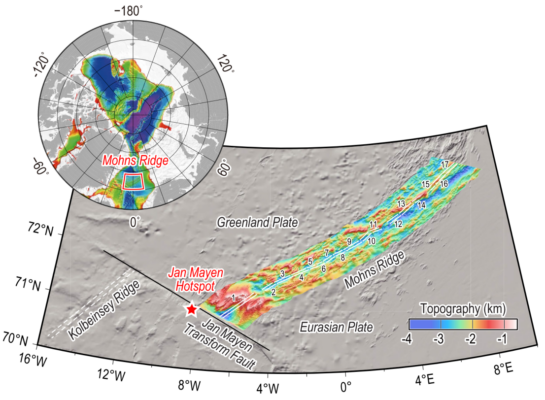
Mid-ocean ridges (MOR) and hotspots are two types of magmatic activity occurring in the ocean. The MORs are typically associated with another tectonic feature—oceanic transform faults. While numerous studies have focused on the interactions within MORs, hotspots, and transform faults, there has been limited research on cases where a hotspot and a transform fault are located at the same end of a ridge segment. In this blog, Yinuo Zhang, a PhD student at the University of the Chinese Academy of Sciences, presents her work on plume-ridge-transform systems.The result has been published on Geophysical Research Letters in December 2023.
Mid-ocean ridges, where the ocean crust are generated, are controlled by magmatism and tectonic. The ridges are classified by their spreading rates: fast (>5 cm/yr), medium (2.5–5 cm/yr), slow (2–2.5 cm/yr), and ultra-slow (<2 cm/yr), with the overall magma supply tending to decrease as the spreading rate decreases. Thus the hotspots —upwellings of hot, buoyant material from the Earth’s mantle—near the ridges could supply additional magma and heat to mid-ocean ridges. The lateral dispersion of mantle plumes along the ridge axis can be affected by oceanic transform faults, which offset ridge segments characterized by lithosphere of different ages. These faults may either enhance or impede the flow of magma and heat from the plumes into the surrounding crust (Georgen, 2014; Georgen et al., 2001; Georgen & Lin, 2003). This study integrates geophysical data with geodynamic modeling to clarify the role of transform faults in a poor-magma ridge-plume system.
The case of the Mohns ridge in the Arctic Ocean
The Mohns Ridge is an oblique ultra-slow spreading ridge located in the Arctic Ocean, between 70° and 74° N, with a full-spreading rate of 15-17 mm/yr. The Jan Mayen Transform Fault connects to the Mohns Ridge in the south while the Jan Mayen Hotspot is situated approximately 50 km from the ridge terminus and overlaps with the transform fault (Figure 1).
In this study, we first calculated the ridge-segment averaged M factor (the proportion of magma supply contributing to the ridge spreading process), along with crustal thickness, residual bathymetry (the difference between the observed bathymetry and a reference model reflecting the variation of magma supply and thermal structure), and axial depth, using original data sets including bathymetry, free-air gravity anomalies, seafloor age, and sediment thickness (Figure 2). We observe that the oceanic crust thins and the residual bathymetry decreases along the Mohns Ridge from south to north, indicating a reduced magma supply and lower lithospheric temperatures in the northern regions (Figure 2c). The differences from south to north reflect the influence of the Jan Mayen Hotspot diminishing with distance, as moving northeast along the ridge axis results in less pronounced effects from the mantle plume. However, variations in topography—characterized by decreasing M factors and axial relief over approximately 370 km—indicate a limited effective distance of hotspot influence (Figure 2a-b).
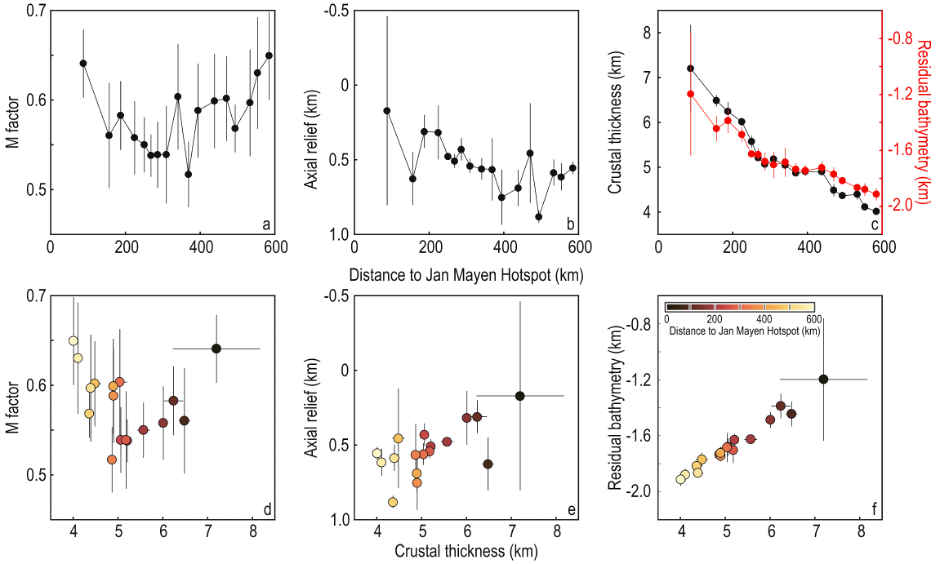
Figure 2. Variations in the segment averaged M factor (a), axial relief (b), and crustal thickness (c) with distance to the Jan Mayen Hotspot, as well as correlations of crustal thickness with M factor (d), axial relief (e), and residual bathymetry (f), respectively. (modified from Zhang et al., 2023)
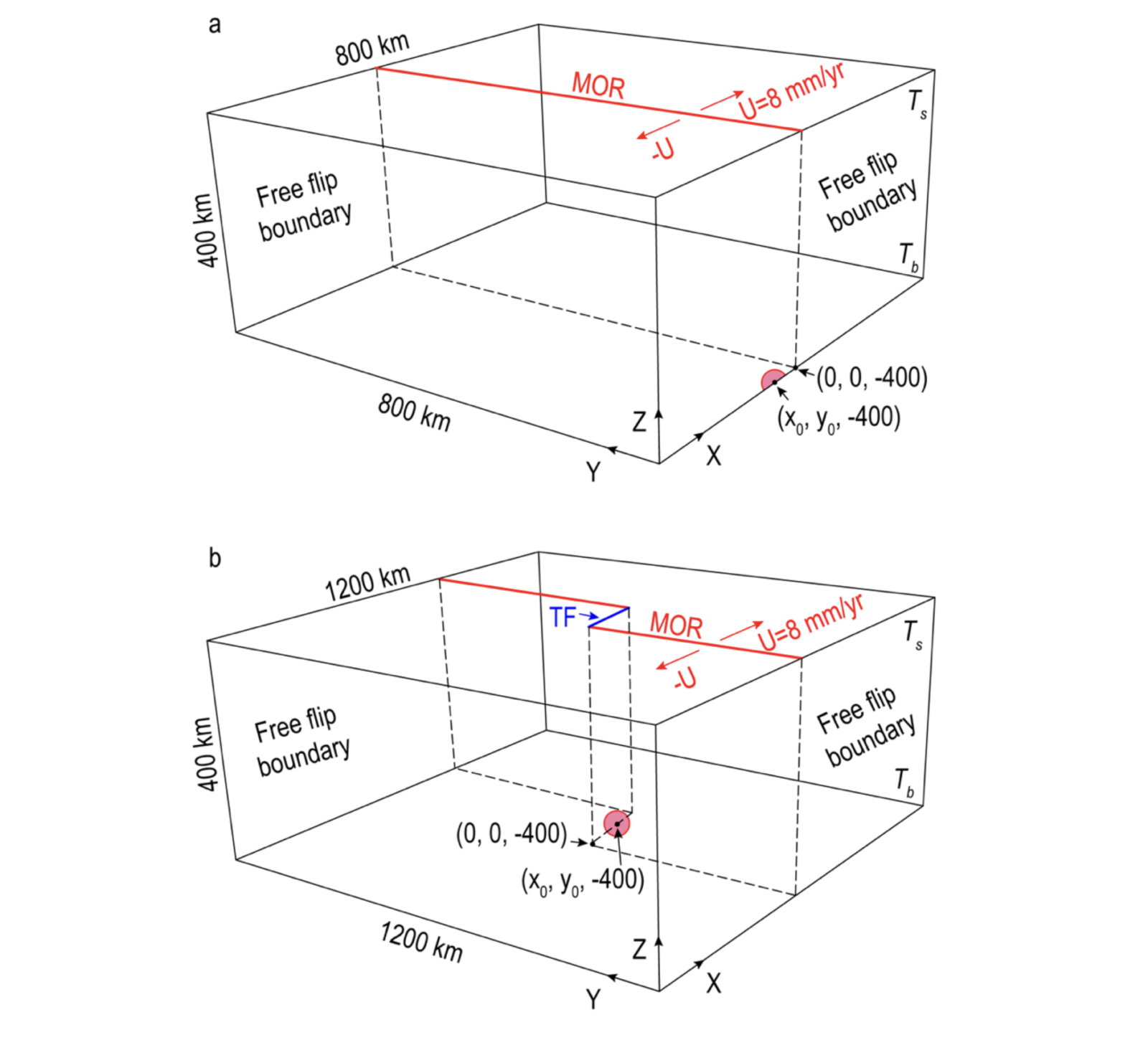
Figure 3. Model setup. (a) Model of interaction between off-axis mantle plume and ultraslow spreading ridge. (b) Model including an oceanic transform fault. The oceanic transform fault is set as 200 km according to the length of Jan Mayen Transform Fault. The half spreading rate U of 8 mm/yr was imposed on the top boundary of the model domain to drive passive mantle upwelling (modified from Zhang et al., 2023).
The geodynamic models of ultraslow spreading ridge: under the effects of the hotspot and transform fault
We wanted to quantify the along-axis influence of hotspot and transform faults. To that end, we set up a three-dimensional geodynamic model of a plume-ridge (P-R) system and of a plume-ridge-transform (P-R-T) system (Figure 3), using the open-source geodynamic tool ASPECT (Heister et al., 2017; Kronbichler et al., 2012). We found that the thermal influence of the Jan Mayen Hotspot extends to ~370 km (Figure 4). The comparison between these two model types indicates that while transform faults can enhance the hotspot’s influence over short distances, they do not significantly impede its overall extent (Figure 5). By finding the best fit with observations of bathymetry, we were able to estimate properties of the Jan Mayen mantle plume, including its diameter, temperature anomaly, and buoyancy flux.
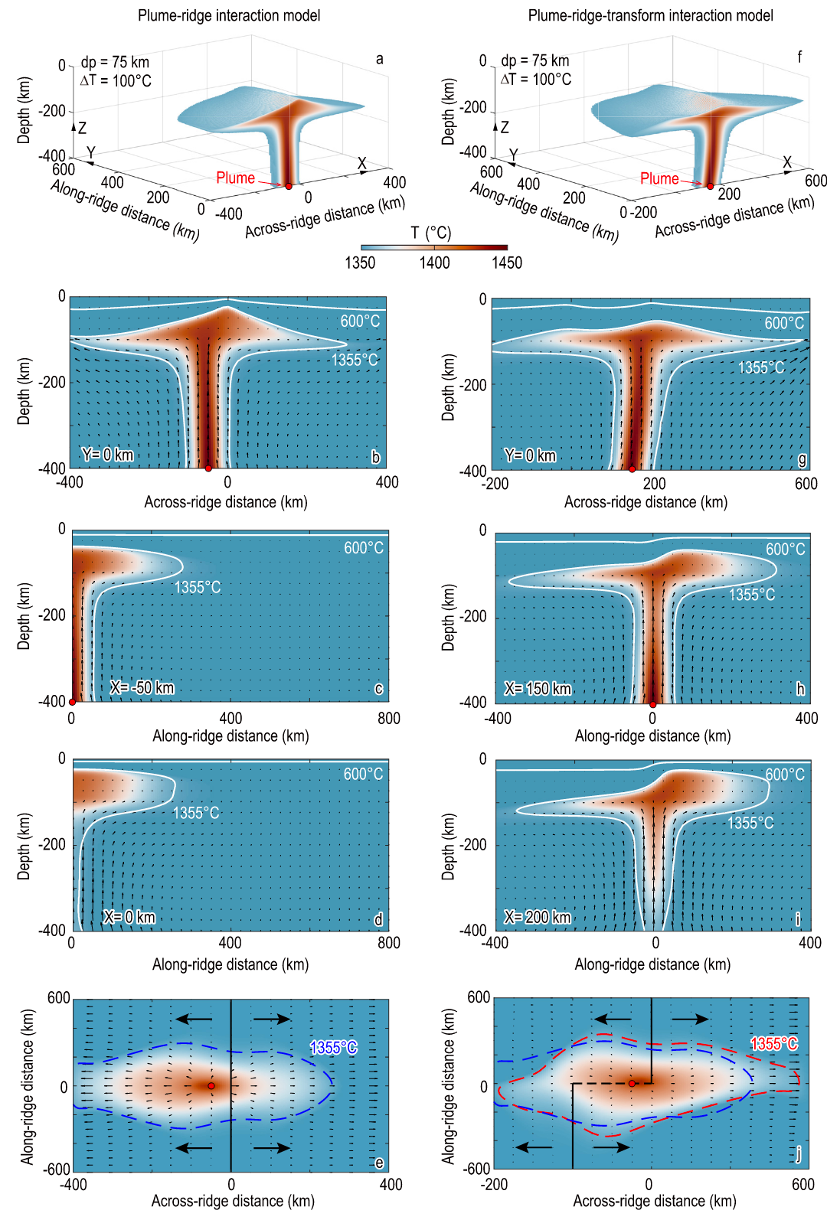
Figure 4. Thermal structures of the best-fitting P-R interaction model (a)–(e) and P-R-T interaction model (f)–(j). dp and ΔT represent the plume diameter and thermal anomaly, respectively. (modified from Zhang et al., 2023)
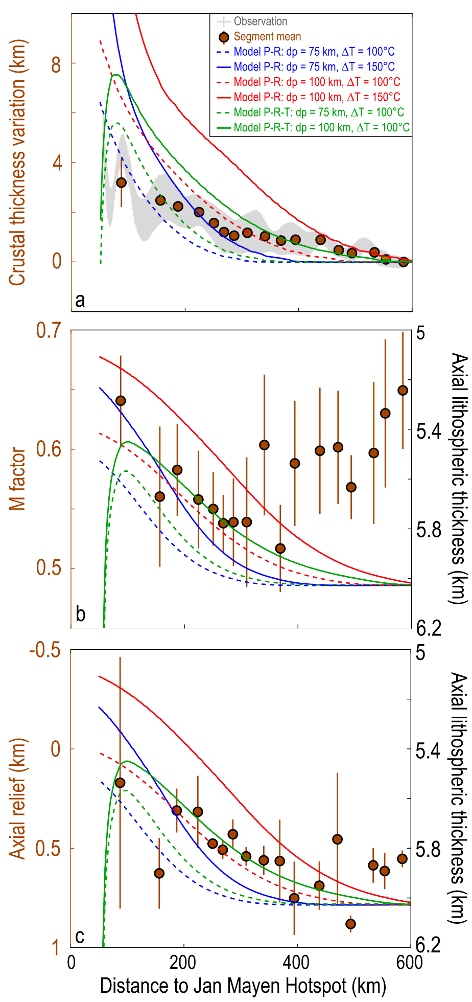
Figure 5. Comparisons of the calculated crustal thickness variation, M factor, and axial relief with geodynamic model results. (modified from Zhang et al., 2023)
This study encourages further exploratio
This study encourages further exploration into the implications of the magma supply in relation to topographic features along ultraslow mid-ocean ridges. Additionally, constrained by the data, we have only observed the effects on the mid-ocean ridge in this case. I am currently working on the influences of mid-ocean ridges on the transform faults in the Mid-Atlantic Ocean, specifically between 29° and 37° N.
References Zhang, Y., Zhang, F., Zhang, X., Zhang, T., Lin, J., Zhou, Z., & Zhang, J. (2023). Modification of Along‐Ridge Topography and Crustal Thickness by Mantle Plume and Oceanic Transform Fault at Ultra‐Slow Spreading Mohns Ridge. Geophysical Research Letters, 50(23), e2023GL105871. Georgen, J. E. (2014). Interaction of a mantle plume and a segmented mid-ocean ridge: Results from numerical modeling. Earth and Planetary Science Letters, 392, 113-120. Georgen, J. E., Lin, J., & Dick, H. J. (2001). Evidence from gravity anomalies for interactions of the Marion and Bouvet hotspots with the Southwest Indian Ridge: Effects of transform offsets. Earth and Planetary Science Letters, 187(3-4), 283-300. Georgen, J. E., & Lin, J. (2003). Plume‐transform interactions at ultra‐slow spreading ridges: Implications for the Southwest Indian Ridge. Geochemistry, Geophysics, Geosystems, 4(9). Heister, T., Dannberg, J., Gassmöller, R., & Bangerth, W. (2017). High accuracy mantle convection simulation through modern numerical methods–II: Realistic models and problems. Geophysical Journal International, 210(2), 833–851. Kronbichler, M., Heister, T., & Bangerth, W. (2012). High accuracy mantle convection simulation through modern numerical methods. Geophysical Journal International, 191(1), 12–29.

